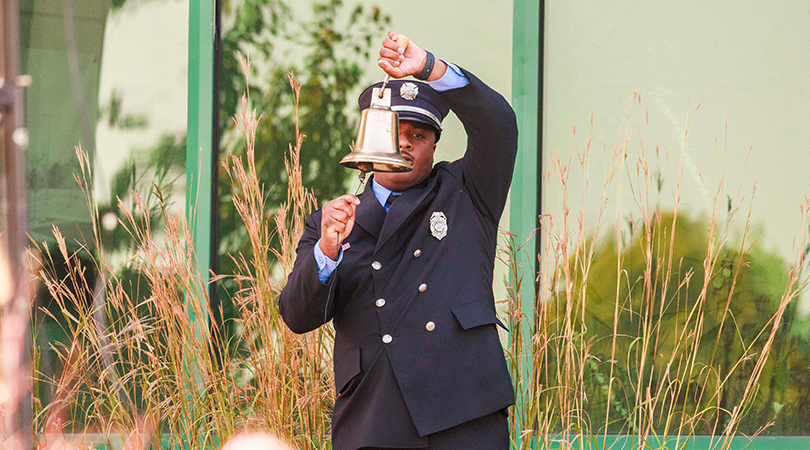The solemnities of moments of national significance are most often introduced by the ringing of bells. The effect is magnified when communities come together in unison, having a clear direction and a shared purpose.
For 250 years, the United States made do with a patchwork of social and political traditions, along with loosely-defined conventions for when and how to ring a bell at such moments. These were spread over a variety of public venues including: churchyards and religious structures; cemeteries and ships; meetinghouses and statehouses; and parks and memorials.
In an effort to clarify, to define, to broadcast, and to involve – so that we can ring out together as one nation in celebration or mourning – the Synod on State Ceremonial and Campanological Protocol in the United States was convened over the summer of 2024, to establish a nationwide set of guidelines for bells and bell ringing. The active and ongoing purpose of this endeavor is to create a richer, more stately, and more inclusive soundscape over America.
The result? A blueprint for who, what, when, where, and why to ring bells at designated moments, issued by the U.S. Bell Command.
Synod Delegates
The collected protocols were formulated in consultation with delegates from across the bell ringing specialties and involved traditional loadstar organizations to which communities look in times of uncertainty, including leaders from the following organizations:
- American Bell Association
- Basilica of the National Shrine of the Immaculate Conception
- Guild of Carillonneurs in North America
- Handbell Musicians of America
- National Bell Festival
- North American Guild of Change Ringers
- Washington National Cathedral
When requested and appropriate, bell ringing guidelines are modified to accommodate the superseding prerogative of organizations planning broader state ceremonial activities, including the Office of Protocol, U.S. State Department, and the U.S. Army Military District of Washington.
Considerations
There are many ways to ring a bell. The widely varying nature of both bell installations and the people who ring them inevitably influences what can or cannot be rung. The Synod labored to make guidelines inclusive to this great diversity, recognizing that each bell installation may have differences in:
- Number of Bells
Having a single bell, a few bells, or a great many affects how bells may be rung. A commemoration might call for general ringing, a single bell tolling X times, or bell(s) tolling for X minutes. While it is often possible to ring just a single bell within a multi-bell installation, the converse is not true. - Bell Profile
As varied as the cultures and artistic traditions that created them, bells come in many shapes and sizes, including traditional western, eastern, tubular, Orthodox, and even electronic. - Weight
The sound of a heavy bell typically decays much more slowly than the sound of a lightweight bell, which implies that the speed of tolling of heavier bells should generally be slower than that of lighter bells. Some bells (or sets of bells) may be so light as to make them inappropriate for reflective, solemn occasions. - Method of Hanging
Bells may be hung fixed (dead), swinging partial circle, or swinging full circle. Bells hung fixed can ring at any rate that is supported by their particular striking mechanisms. Bells hung for swinging in a partial circle can only be rung at a rate that is determined by their weight and balance. Bells hung for swinging full circle can be rung at a controlled rate that is no faster than that of the largest bell of a set in traversing a full circle, but can also be rung at a slower rate if desired. Swinging bells might also be fully-muffled or half-muffled to influence their perceived sound. - Method of Control
Tower bells may be sounded in a manner that is manual, fixed automatic, or programmable automatic. Some installations may have only one method of control, while others have two or three methods. Handbells and change ringing require the coordination of teams of people. - Musical Capability
A musical performance on bells might comprise a single melody or a full recital. While traditional carillons are generally capable of playing all music (suitably arranged for their size and weight), other multi-bell installations are less capable. Many chimes, non-traditional carillons, and electronic devices play only single-note melodies. Peals of swinging bells cannot be used to play music, nor can the zvons of Orthodox churches. - Ordinary Uses
Whether these are liturgical or secular, it is essential to consider how, or even whether, the ordinary schedule of use of a particular installation can be adapted or interrupted for state ceremonial use. For example, a single-purpose clock bell or clock chime may be impossible to adapt to such a use, whereas a carillonist might be more able to accommodate a change in repertoire or performance schedule. Silence, or the removal and absence of bell ringing, might also be a useful deviation from ordinary use. - Location
Depending on the occasion, it might be appropriate for a single bell in a single location to toll. At other times, bells within a specific city, state, or region might be rung. At our most momentous occasions, as many bells as possible might be called upon to ring nationwide.
For any particular bell installation, all of these aspects must be considered in order to determine whether (and how) it can be used appropriately for a particular state ceremonial occasion. When possible, the number or duration of tolls established in the protocols have been imbued with meaning relevant to the occasion, leveraging American symbology and history where possible.
Cover image: A Bloomington firefighter rings a ceremonial bell during the Bloomington Fire Department's annual 9/11 remembrance ceremony at Ivy Tech in Bloomington, Indiana, on Sept. 11, 2025.

